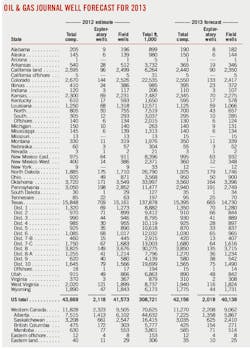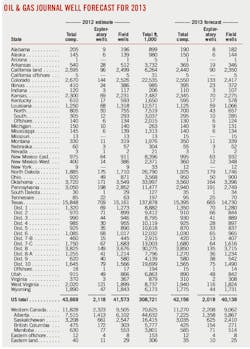The year 2013 could be a lackluster period for overall well completions in the US and Canada with declines possible if not likely in both countries.
OGJ compiles its own forecast of the number of wells being drilled using rig counts, oil and gas prices, play trends, and other data.
Several clear trends in 2012 US activity can be expected to continue in 2013. Among these are the drilling of slightly fewer wells overall and the diversion of rigs from gassy areas to plays in which liquids completions are more likely.
Here are highlights of OGJ's early year drilling forecast:
• Operators will drill 42,156 wells in the US, down from an OGJ estimated 43,669 wells in 2012.
• All operators will drill 2,018 exploratory wells of all types, down from an estimated 2,118 last year.
• Operators will drill 11,270 wells in western Canada, down from an OGJ-estimated 11,828 wells in 2012.
US 2012 drilling
Drillers had 1,763 rigs turning to the right in the US as 2012 ended, compared with about 2,000 rigs that ran for nearly the entire first half of the year.
Weakening oil prices and persistently low gas prices caused operators to begin whittling away at the rig count as the second half began (OGJ, July 2, 2012, p. 42).
Still, the rig count averaged 1,925 rigs in 2012 through mid-December compared with 1,873 in the same period of 2011, and many states and districts showed healthy year-to-year increases.
States and areas that host the gassier plays mostly sustained rig losses in the second half of 2012. Arkansas suffered as operators retracted drilling in the Fayetteville shale play. Haynesville and Bossier drilling declined in North Louisiana and East Texas Dist. 6, and western East Texas Dist. 5 averaged fewer than half the rigs that had been active 2011.
Pennsylvania rig activity averaged 100 rigs/week in the first half of 2012 but only 85 rigs/week for the full year.
US 2013 forecast
OGJ looks for a decline of about 3.5% in US drilling in 2013 with wider fluctuations down and up in individual states and areas.
Leading areas in numbers of rigs for US drilling in 2013 will be West Texas-New Mexico, the multidistrict South Texas Eagle Ford play, North Dakota, and Oklahoma.
The array of tight oil and shale oil plays in the Permian basin has attracted in the neighborhood of 400 rigs to that area.
North Dakota had 174 active rigs in the last week of December 2012, compared with averages of 188 for the year 2012 and 168 in 2011. OGJ forecasts an increase in North Dakota in 2013 with realization that the Three Forks formation may support separate wells from the Bakken formation across large parts of the Williston basin.
Further contraction is expected in the Haynesville play. Operators continue to run a few rigs each in pursuit of commerciality in the Tuscaloosa marine shale and Smackover Brown Dense formations.
Rigs are being added slowly to the Niobrara play in eastern Colorado and the Mississippi lime play in northern Oklahoma and western Kansas.
Canadian outlook
Rig activity has been relatively weak in Canada, where gas drilling has dwindled to only about 20% of the total rig count.
The Canadian Association of Oilwell Drilling Contractors in mid-November forecast that the industry will drill 10,409 wells in Canada in 2013 or about 6% fewer wells than in 2012.
CAODC said it arrived at the 2013 figure "based on continued uncertainty around commodity prices" and noted that the industry is "engaged in complex drilling programs that require more time to drill."
The association said fewer than 400 rigs have been active recently out of a fleet of 830 and that it does not expect its members to expand the rig roster in 2013.
Even though gas drilling remains depressed in Canada, a longer term demand increase for liquefied natural gas could reverse this trend at some point.
CAODC noted that the operating cycle in Canada is for the highest rig utilization in the first quarter, a drop in the second quarter due to spring break-up, a nominal increase in the third quarter, and a further pick-up in the fourth quarter.

